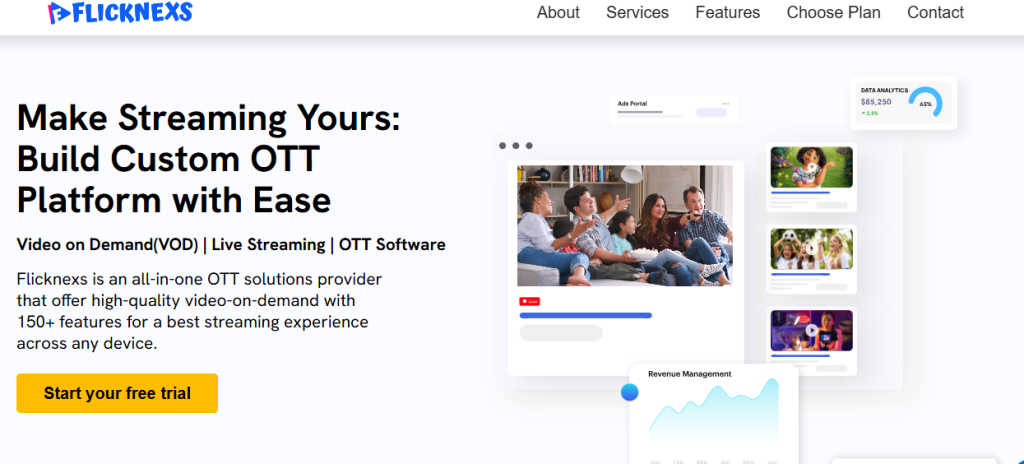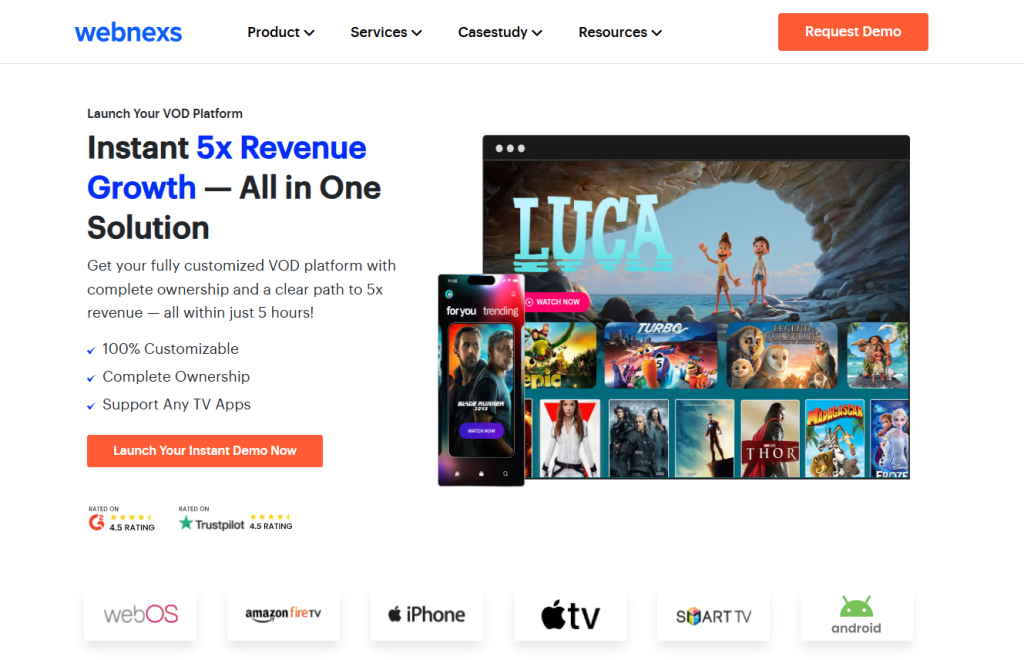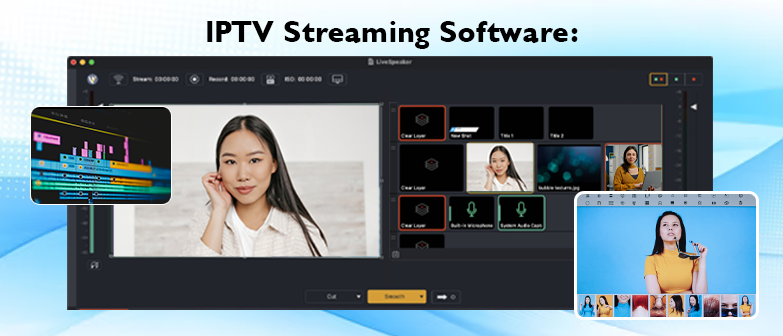As of 2025, over 1.8 billion people watch TV via internet-based platforms, while traditional cable subscriptions continue to decline. This shift marks a new era of smart, personalized, and on-demand viewing powered by digital technology.
From Netflix to enterprise IPTV solutions, audiences now expect flexibility—watching anything, anytime, on any device.
That’s where IPTV streaming software comes in: the core technology that delivers live and on-demand video content over the internet with high quality and scalability.
In this guide, we’ll cover:
- What IPTV streaming software is
- How it works
- Key features and benefits
- Industry applications
- And the top IPTV tools shaping 2025
TL;DR (Quick Summary)
- IPTV (Internet Protocol Television) delivers live and on-demand video content over the internet instead of traditional cable or satellite.
- IPTV streaming software enables broadcasters, telecoms, educators, and content creators to manage, deliver, and monetize video content efficiently.
- Key features include EPG (Electronic Program Guide), VOD (Video-on-Demand), multi-screen support, recording, and time-shifted TV.
- The best IPTV software platforms in 2025 include Flicknexs, Webnexs IPTV, Kodi, and Plex.
- IPTV offers cost efficiency, flexibility, global reach, and customization for both providers and audiences.
What Is IPTV Streaming Software?
IPTV (Internet Protocol Television) is a system that delivers television content using internet protocol networks instead of traditional terrestrial, satellite, or cable formats.
IPTV streaming software is the application layer that makes this possible. It lets users access live TV, VOD (video on demand), and interactive services from any internet-connected device, including smartphones, laptops, and smart TVs.
Why It Matters in 2025
As broadband penetration and 5G connectivity expand globally, IPTV is becoming the preferred delivery model for both broadcasters and independent creators.
Businesses now use IPTV not only for entertainment but also for training, internal communication, and customer engagement.
How Does IPTV Streaming Software Work?
IPTV software acts as the bridge between the content provider and the viewer.
Here’s a simplified flow:
- Content Acquisition: The software receives a video feed from a broadcaster, camera, or storage.
- Encoding and Compression: The video is converted into digital IP packets optimized for internet delivery (H.264/H.265).
- Transmission via IPTV Server: The encoded stream is delivered to the viewer’s device via a content delivery network (CDN).
- Decoding and Playback: The IPTV software on the viewer’s device decodes the stream and plays it instantly.
Unlike traditional broadcasting, IPTV offers bi-directional communication, enabling interactive features such as pause, rewind, or pay-per-view.
Types of IPTV Streaming Software
| Type | Description | Typical Users |
|---|---|---|
| Native Apps | Designed for a single OS (e.g., Android TV, iOS). Offers high performance. | Consumers, OTT startups |
| Cross-Platform Apps | Works across multiple OS and devices. Offers flexibility. | Broadcasters, telecoms |
| Web-Based Players | No installation needed, runs directly in browsers. | Educational institutions, corporate users |
| Hybrid IPTV Platforms | Combines live TV with on-demand content and analytics. | Media enterprises, ISPs |
In 2025, hybrid platforms are leading the market because they support multi-device streaming, cloud scalability, and data-driven personalization.
Key Features of IPTV Streaming Software
Modern IPTV software includes features designed for both content delivery and viewer engagement.
Electronic Program Guide (EPG)
Displays schedules for upcoming shows, movies, and live events, giving viewers a complete programming overview.
Example: Netflix’s “Coming Soon” tab functions similarly by providing next-release insights.
Channel Management
A well-organized channel list makes it easy to browse content by genre, region, or language improving accessibility and user satisfaction.
Video-on-Demand (VOD)
Lets users stream content anytime. Advanced IPTV platforms support adaptive bitrate streaming for consistent quality.
Time-Shifted TV & Catch-Up
These features allow viewers to pause, rewind, and replay live broadcasts, creating a truly flexible experience.
Multi-Screen & Multi-User Support
A key 2025 expectation households or teams can stream multiple channels on different devices simultaneously.
Cloud DVR (Recording)
Enables users to record live shows and store them on the cloud for later playback.
Security & DRM Integration
Essential for protecting copyrighted content using AES encryption and Digital Rights Management (DRM).
Monetization Tools
From subscription billing to pay-per-view models and ad insertion, IPTV software enables multiple revenue streams.
Analytics & Reporting
Advanced analytics dashboards provide insights into viewer behavior, engagement duration, and top-performing content.
Benefits of IPTV Streaming Software
For Content Providers
- Wider Reach: Stream globally across devices without needing cable infrastructure.
- Reduced Distribution Costs: No need for satellite uplinks or hardware-based broadcasting.
- Custom Branding: White-label options allow providers to launch branded OTT services.
- Monetization Flexibility: Subscriptions, ads, and hybrid payment models.
- Data-Driven Insights: Analytics helps refine programming and marketing.
For Viewers
- On-Demand Access: Watch anytime, anywhere.
- Personalized Experiences: Recommendations based on preferences.
- Interactive Viewing: Pause, rewind, and record.
- High-Quality Streams: 4K and HDR streaming supported with adaptive delivery.
Factors to Consider When Choosing IPTV Streaming Software
Device Compatibility
Ensure compatibility with Android, iOS, Web, and Smart TVs to maximize audience coverage.
Interface and User Experience
A modern UI increases engagement. Look for platforms offering customizable themes, dark mode, and voice search.
Content Delivery and CDN Integration
A global CDN ensures minimal buffering and high availability.
Video Quality & Encoding
Choose software supporting adaptive bitrate (ABR), H.264/H.265, and 4K UHD output.
Security and Compliance
Compliance with GDPR, DMCA, and DRM standards is crucial for enterprise-grade IPTV systems.
Scalability
Your platform should support thousands of concurrent streams and grow with audience demand.
Customer Support and API Integrations
Look for 24/7 support and API access for integrations with CRMs or marketing automation tools.
Top IPTV Streaming Software in 2025
Below are some leading IPTV software platforms that combine scalability, usability, and innovation.
Flicknexs

A cloud-hosted IPTV platform offering end-to-end solutions for broadcasters, ISPs, and media startups.
Highlights:
- White-label streaming
- Built-in CDN
- Monetization via ads/subscriptions
- API integrations for analytics and billing
Webnexs IPTV

Delivers 12,000+ channels globally with live and on-demand options.
Highlights:
- Supports Android, iOS, Fire TV, and Smart TVs
- EPG and catch-up TV
- Multi-user access
- Multi-tier monetization models
Kodi
An open-source IPTV software ideal for hobbyists and developers.
Highlights:
- Free and customizable
- Plugin-based ecosystem
- Compatible with most IPTV lists
Plex
A media management system with IPTV streaming capability.
Highlights:
- Personal media server setup
- Cross-platform access
- Live TV and DVR functionality
Snippet Summary:
“In 2025, top IPTV software includes Flicknexs, Webnexs IPTV, Kodi, and Plex, offering scalable live streaming, video-on-demand, and multi-device compatibility for global audiences.”
Industry Applications of IPTV
| Industry | Use Case |
|---|---|
| Education | Deliver lectures, webinars, and campus announcements via IPTV networks. |
| Healthcare | Stream patient education, telemedicine tutorials, or internal training. |
| Hospitality | Offer personalized in-room entertainment and guest communication. |
| Corporate | Broadcast town halls, onboarding sessions, and internal updates. |
| Sports & Events | Stream live matches and pay-per-view content globally. |
| Government & Public Sector | Distribute public announcements and e-learning content securely. |
Future Trends in IPTV (2025–2030)
The IPTV industry is evolving rapidly as technology and viewer expectations continue to grow. Here are five major trends shaping the future of IPTV:
1. AI-Powered Personalization
Artificial Intelligence is redefining content delivery. IPTV platforms now use AI to analyze viewing behavior, recommend tailored shows, and optimize ad placement, creating a more engaging and relevant experience for users.
2. 5G and Low-Latency Streaming
The global rollout of 5G networks is enabling faster, smoother, and ultra-HD streaming. This improvement eliminates buffering, making live sports, remote education, and corporate broadcasts seamless.
3. Cloud-Based Infrastructure
Cloud-native IPTV solutions are replacing traditional hardware systems. They provide greater scalability, lower costs, and easier management, making them ideal for startups, telecom providers, and media enterprises alike.
4. Interactive and Immersive Viewing
Next-gen IPTV platforms are integrating VR, AR, and interactive elements like polls and multiple camera angles, transforming passive watching into participatory experiences.
5. Smarter Monetization Models
Beyond subscriptions, IPTV services are adopting hybrid revenue models that mix ads, pay-per-view, and tiered access to ensure profitability while maintaining viewer satisfaction.
Common Challenges & Solutions
| Challenge | Solution |
|---|---|
| Buffering or Lag | Use global CDN and adaptive bitrate streaming. |
| Piracy | Implement DRM and encryption. |
| Device Fragmentation | Opt for cross-platform compatibility. |
| Content Licensing | Use official, verified sources and licensing agreements. |
| Scalability | Choose cloud-based or hybrid IPTV architectures. |
Legal & Compliance Considerations
IPTV is fully legal when licensed content and authorized services are used.
Avoid unverified IPTV lists or unauthorized streams to ensure compliance with copyright laws and platform policies.
Key standards and organizations:
- PCI DSS for payment security
- GDPR for user data
- FCC (USA) and Ofcom (UK) for broadcast regulations
Conclusion
The rise of IPTV streaming software represents the next phase of the digital broadcast revolution. By merging the internet’s flexibility with television’s engagement power, IPTV is transforming how content is distributed, monetized, and experienced.
In 2025, businesses, broadcasters, and creators have more tools than ever to reach audiences globally all through software-driven, data-informed, and interactive streaming solutions.
Whether you’re a startup launching your first channel or an enterprise scaling video delivery, IPTV offers a future-proof pathway to stay ahead in the new world of connected entertainment.



Leave a Reply